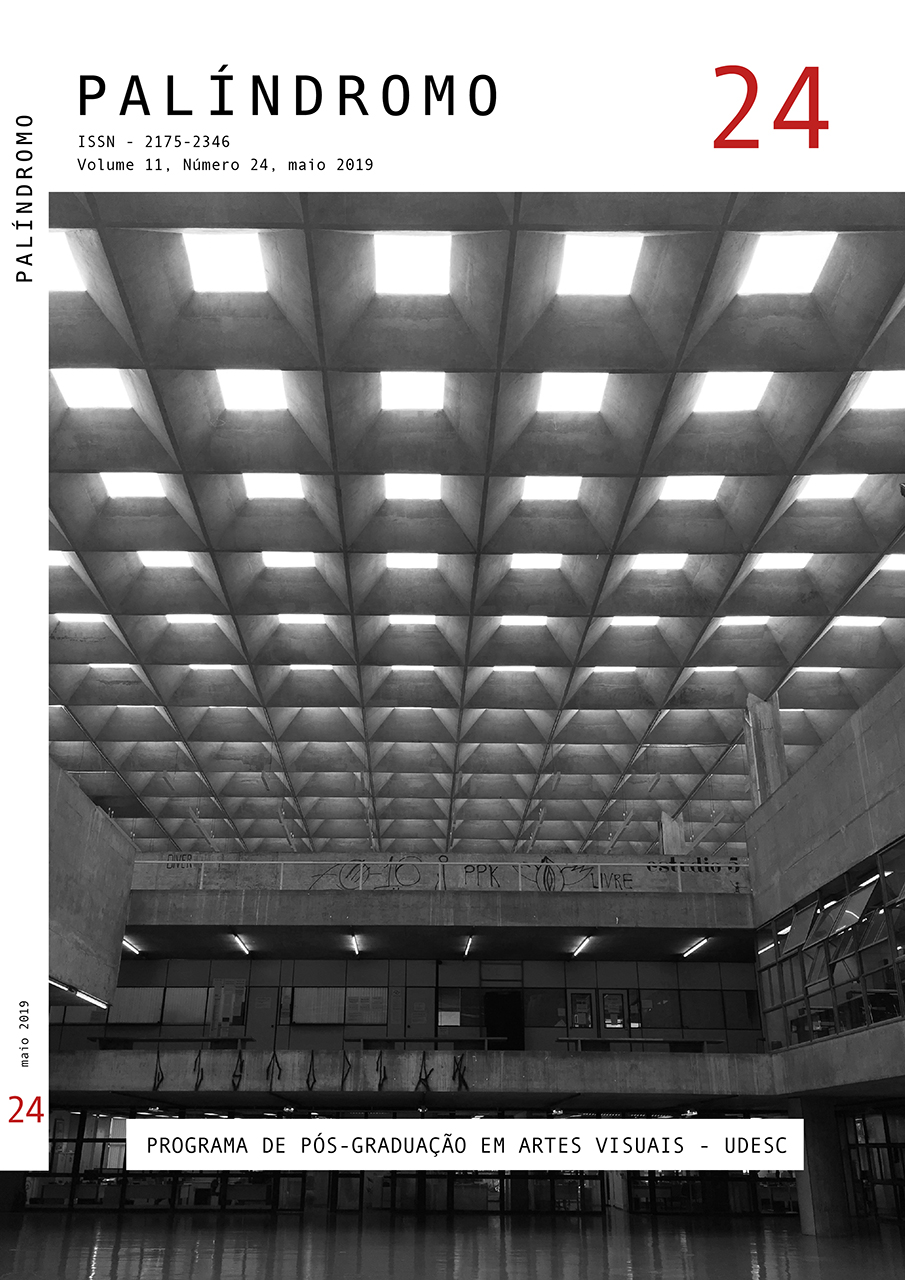Hilma af Klint: from the spirit to matter
DOI:
https://doi.org/10.5965/2175234611242019042Keywords:
Hilma af Klint, abstractionism, art, aura, spiritualityAbstract
The multiple questions related to the esoteric work of Hilma af Klint are in-creasingly relevant nowadays. The move-ment around the artist is not by chance. From the dubious title of abstractionist avant-garde pioneer to an expressive link between the spiritual and the mate-rial world, the artist is emphasized by the coinciding paths in the artistic universe of Wassily Kandinsky and Piet Mondrian, through concepts and philosophy based on Helena Blavatsky and Rudolf Stein-er Theosophy, which would be in wide circulation aiming a spiritual search vis-à-vis the modernist progress at the end of the 19th century. Hilma af Klint, how-ever, presents a trajectory of her own in which her spirituality overlays her work with a deeply religious and mediumistic character, not found in her already men-tioned pairs. Behaving less as a modern artist and more as a priestess, Klint and her work inquire what Walter Benja-min would conceptualize as the auratic character of works of art, since her work stresses the secular and the divine, the traditional and the modern in a unique way and quite different from what would be done by the abstractionists.
Downloads
References
ARAÚJO, Bráulio S. R. O conceito de aura, de Walter Benjamin, e a indústria cultural. Revista Pós, São Paulo, v.16, n. 28, p. 120-143, 2010.
BECHOFER-ROBERTS, C. E. Mysterious Madame Helena Petrovna Blavatsky. Kessin-ger Publishing, 2003.
BENJAMIN, Walter. Magia e Técnica, Arte e Política: ensaios sobre literatura e história da cultura. São Paulo: Brasiliense, 2014.
BESANT, Annie.; LEADBEATER, Charles Webster. Formas de Pensamento. São Paulo: Pensamento, 1995.
CARVALHO, José Jorge. Antropologia e Esoterismo: dois contradiscursos da moder-nidade. Horizontes Antropológicos, Porto Alegre, v.4, n. 8, p. 53-71, 1998.
GOETHE, J.W. Doutrina das Cores. São Paulo: Nova Alexandria, 1993.
HILMA AF KLINT FOUNDATION. Disponível em: <http://www.hilmaafklint.se/hilma--af-klint- foundation/>. Acesso em: 12 Abr. 2018.
KANDINSKY, Wassily. Do Espiritual na Arte e na pintura em particular. São Paulo: Martins Fontes, 1996.
LEINER, Sheila. Mostra ‘Mundos Possíveis’ reúne 130 obras de Hilma af Klint, Dispo-nível em: <https://cultura.estadao.com.br/noticias/artes,mostra-mundos- possiveis--reune-130-obras-de-hilma-af-klint,70002214884>. Acesso em: 12. Março 2018.
MARCUSE, Hebert. Sobre o caráter afirmativo de cultura. Cultura e sociedade. 2 ed. Rio de Janeiro: Paz e Terra, 1997.
PEREIRA, Wilcon. Piet Mondrian, um percurso. Revista de Letras, São Paulo, v.16, p. 231-251, 1974.
PENEDA, João et al. O espiritual na arte a partir de Kandinsky. In: ESOTERISMO OCI-DENTAL, 1., 2016, Lisboa. Anais... Lisboa: Universidade Lusófona, 2016. p. 110-123.
SCHAPIRO, Meyer. Mondrian: a dimensão humana da pintura abstrata. São Paulo: Cosac & Naify, 2001.
SKIDMORE, Maisie. Decoding the Spiritual Symbolism of Artist Hilma af Klint, março 2016. Disponível em: <http://www.anothermag.com/art-photography/8490/deco-ding-the- spiritual-symbolism-of-artist-hilma-af-klint>. Acesso em: 30 Jun. 2018.
TAKAC, Balasz. What Does Hilma af Klint Mean for Brazil? Pinacoteca’s Jochen Volz Explains, junho 2018. Disponível em: <https://www.widewalls.ch/hilma-af-klint-pi-nacoteca- sao-paulo/>. Acesso em: 03 Jul. 2018.
STEINER, Rudolf. Teosofia: Introdução ao conhecimento supra-sensível do mundo e do destino humano. São Paulo: Antroposófica, 1996.
VÁRALJAI, Anna et al. Theosophic Arte and Theosophic Aesthetic in Hungary In Ten Years, in the Aspect of the Theosophical Society Journal. In: ESOTERISMO OCIDENTAL, 1., 2016, Lisboa. Anais... Lisboa: Universidade Lusófona, 2016. p. 156-165.
WASSILY KANDINSKY. Disponível em: <http://www.wassilykandinsky.net/>. Acesso em: 20 Jun. 2018.
Downloads
Published
How to Cite
Issue
Section
License
Copyright (c) 2019 Palíndromo

This work is licensed under a Creative Commons Attribution 4.0 International License.
COPYRIGHT STATEMENT
The articles published by the magazine are free to use, intended for academic and non-commercial applications. Copyright is all assigned to the magazine. The articles whose authors are identified represent the expression from the point of view of their authors and not the official position of Palíndromo Magazine. The author (s) commits to whenever they publish material referring to the article published in Palíndromo mention this publication as follows:
This article was originally published by Palíndromo magazine in its volume (place the volume), number (place the number) in the year of (place the year) and can be accessed at: http://www.revistas.udesc.br/index.php/palindromo


